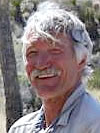
Leslie D. McFadden
University of New Mexico
2017 Kirk Bryan Award
Presented to Leslie D. McFadden
for
McFadden, L.D. 2013. Strongly dust‐influenced soils and what they tell us about landscape dynamics in vegetated aridlandsof the southwestern United States, in Bickford, M.E., ed., The Web of Geological Sciences, Impacts, and Interactions: Geological Society of America Special Paper 500. P. 501-‐532.
Citation by Amy Brock-Hon
In his 2013 paper, McFadden asks “Why do numerous soil scientists, mainly geomorphologists and other Earth scientists seemingly remain unaware of this model [of aeolian inflated profiles], or even reject it?” This question, seemingly asked out of frustration, is evident to me as the impetus for this paper. McFadden (2013) is deserving of the Kirk Bryan Award because it provides a foundation of soil-development knowledge that should be read by anyone working on soil geomorphology and related problems in aridlands. Importantly, it elucidates the role of dust in soil development and landscape dynamics, something that still should be emphasized, even after over 5 decades of research in the southwestern United States.
In this paper, McFadden has written a concise review of the evolution of aridland models of soil development, from the application of Jenny’s classic A/B/C weathering profile to the contributions of the Desert Soil Geomorphology Project, and identification of dust-inflated desert pavement formation at the Cima volcanic field. In doing so, he not only highlights our current understanding of aridland soil-profile development, but also explains the importance of dust and aeolian materials as major contributors to chemical and morphological changes tied to landscape processes. More importantly, McFadden presents the inclusive AIP (Accretionary and Inflationary Profile) model and its application to numerical modeling of soil-landscape processes and soil-production rates, hillslope evolution, and the influence of biotic communities and their response to climate change (just to name a few).
With aridlands as the locales of recent and ongoing wars, population growth, and sites of new energy resources (solar and wind farms), the impact of fully understanding aridland processes discussed in this paper goes beyond the disciplines of Quaternary Geology and Geomorphology.
 2017 Kirk Bryan Award — Response by Leslie D. McFadden
2017 Kirk Bryan Award — Response by Leslie D. McFadden
I am deeply honored to have received the 2017 Kirk Bryan Award, and would like to thank Amy Brock-Hon, who spearheaded the nomination, those who submitted supporting letters, and the GSA Kirk Bryan Award committee for selecting this paper, which was published in the GSA Special Paper 500 in 2013. In late 2011, I was contacted by Pat Bickford, who offered me the opportunity to contribute a paper to a volume he was editing as part of the 125th anniversary of GSA that celebrated advances in geosciences over the last several decades. Initially, Pat asked me to contribute a paper addressing “Weathering, development of soils, and/or regolith.” Period. Ultimately, Pat graciously agreed to my counterproposal to contribute a paper focusing on research concerning soils and landscapes, primarily in sparsely vegetated aridlands. I was inspired to take on the task for a few reasons, one being my great admiration of the contributions of scientists such as Hans Jenny, Daniel Yaalon, Ran Gerson, Robert Ruhe, Lee Gile, and B.L. Allen towards the understanding of pedogenesis in aridlands; a second one being, as Amy Brock-Hon alludes to in her citation, my sense that many of the key lessons of these scientists and more recent soil geomorphological research were, to try to put it diplomatically, rather underappreciated by a new generation of geomorphologists in the study of, for example, desert pavements or weathering rates and soil development in hilly landscapes.
Like all others who have received the Kirk Bryan Award, many of the ideas or concepts included in the paper reflect the influences of many others, such as those aforementioned scientists, but also former mentors and those with whom I have collaborated in soils and geomorphological research during the past nearly forty years. I have had, as the current president of our country might put it, the tremendous fortune to have had many such colleagues during my academic career, and it would be wonderful to be able to identify them all. But given huge time and space limitations, I cannot at this time do that. Sad. But I do think it essential to note those who, in the end, really have very critically affected my methodological and philosophical approaches to soil geomorphological research. Ultimately, they include: Pete Birkeland: his greatly influential textbook, Pedology, Weathering and Geomorphological Research, was that used in my first soil class. The second edition of this textbook, much of which was organized around the CLORPT Fundamental Equation of Jenny, ultimately received the Kirk Bryan Award. Regina Capuano: she finally convinced me of the great potential of numerical modeling of low temperature rock-water systems as applied to many areas of soil geomorphological research. Steve Wells: Steve introduced me to the beautiful and sublime landscapes of the Colorado Plateau and with whom I began to see desert pavements and soils in a very different light as we embarked upon collaborative research in the Mojave Desert in the early 1980s. Joe McAuliffe: Joe, a truly gifted ecologist, has opened my eyes to the profound impacts and intricate relationships of desert plants to aridland soils in diverse geomorphic circumstances, beyond those related to soil respiration and limited organic matter accumulation. Finally, Bill Bull, who first recommended that I consider taking that first soils class at the University of Arizona all those years ago. His textbook, Geomorphic Responses to Climate Change, also received the Kirk Bryan Award. I see landscapes—and in many ways, soils—largely through the eyes of this great scientist.
